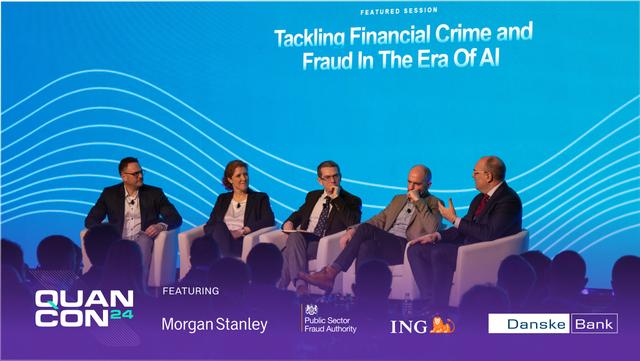The Truth About Augmenting Your Financial Crime And Fraud Programs
See how banks can repurpose and augment existing technology to enhance financial crime and fraud programs by maximizing the value of data.
Money laundering enables criminals to disguise ill-gotten gains as legitimate transactions and is one of the biggest threats to the financial sector. Such activities facilitate crime and threaten security as they allow drug traffickers, fraudsters, human trafficking organizations, and corrupt officials to operate and expand their criminal enterprises. In other words, money laundering is essential for crime syndicates to grow and become more profitable.
Meanwhile, fraud remains the largest and most significant proceed-generating crime for which funds are then laundered. Criminals make billions of dollars annually from different fraud schemes with the most pervasive coming from scams aimed at cheating banking customers out of their money.
The volume of scams is soaring while criminals running these schemes are becoming far more proficient according to a report from Retail Banking International (RBI). Citing Mitek's Identity Intelligence Index 2024, a major area of concern is that almost a third (32%) of the risk professionals surveyed estimate that up to 30% of all transactions are fraudulent with mule activity connected to drug trafficking being a major driver.
Identifying money laundering risks and behaviors is an ever-changing and dynamic process with crimes like fraud, drug and human trafficking, cybercrime, corruption, and human smuggling remaining the most significant proceed-generating activities associated with money laundering.
As the landscape for money laundering risk evolves, so do the challenges faced by banks. For example, criminals, scammers, and illicit actors are increasingly using virtual assets and digital, peer-to-peer payment systems to engage in fraud and other crimes that are then tied to money laundering.
To compete against the multi-pronged strategies of criminal organizations, banks need a way to track where the proceeds from these scams go to uncover criminal rings and points of compromise.
As financial crime and fraud teams look to the future, several things are almost certain to happen:
Government regulations will continue to tighten;
Banks will become responsible for covering the losses of customers victimized by scams;
Banks of all sizes will need a way to identify strategies and technology to proactively protect their customers and themselves;
Banks will need to identify patterns of activity and look for common points of interest to track the flow of funds for reporting while taking appropriate preventative measures.
The rise of augmentation
To meet these rising challenges, many banks will turn to the incumbent solutions they already have in place to help mitigate financial crimes.
However, the problem with these older solutions is that they were designed to handle one objective and while they may mature, they weren’t created to work alongside a competitor's platform and the market interactively to materially change. More importantly, many legacy technologies cannot provide a full, 360-degree view of a bank's customers and their counterparties, which is critical to mitigating financial crimes and fraud proactively and staying ahead of evolving compliance regulations.
"Ripping and replacing" incumbent solutions is both costly and impractical, which leaves banking security professionals asking: How can we reduce financial crimes by augmenting the solutions we have in place to provide a full view of our customers to meet regulatory expectations that are sure to come?
The answer to this question lies in overlaying extant solutions with new technologies that augment the capabilities of incumbent solutions. New technologies, like Entity Resolution, leverage AI to stitch together siloed and often disparate bits of information from both internal and external data sources to provide a full view of customers and those they associate with.
Quantexa's Decision Intelligence Platform allows financial crime directors to look both inside and outside of a bank’s network. Overlaying existing solutions with Quantexa's Contextual Monitoring capability allows investigative teams to identify multiple red flags or “clusters” of transactions at a network level and aggregate risk to a scorecard to see the entire network of risk.
This ability to move alerts beyond following single transactions that often end in false positives can help determine whether the money came from a questionable source and, most importantly, where it went. And the best news is that the same Quantexa platform that may be in use elsewhere in your organization can be easily repurposed for use across multiple lines of business to augment anti-money laundering efforts.
Overcoming augmentation challenges
Some banking IT professionals might argue that augmenting incumbent solutions is all but impossible due to the difficulty in data being formatted for specific outcomes. How are you able to take existing data and stitch that data together? How are you supposed to get meaningful insights into data that wasn't inherently designed to be put together?
The same applies to outcomes. When we look at particular financial crimes where alerts are generated, alerts have certain data fields built into them. Those data fields may be different from one vendor to the next. So how do you use that data and how can an analyst provide clarity to the reasons for that alert being generated but also stitch other related and potentially related alerts together to make sure they're seeing a complete view of that suspicious activity?
The beauty of using Quantexa's platform is that these objections don't matter. The platform is designed to consume data in its existing state. It then stitches everything together from how we view entity profiles and transactions to building the foundation for networks. Building this trusted data foundation (a single source of truth), which has already been completed if you're using Quantexa in another part of the bank, is the most time-consuming task.
Once this trusted data foundation is established, however, the heavy lifting is over. Now this database can be used elsewhere in a banking organization, with only minor adjustments, to customize it for specific use cases. Analysts need only point new use cases to the data to get the outcomes they desire whether they're investigating shell companies, scams, mules, account takeovers, phoenixing, or controlling minds.
How it works
In its simplest definition, augmentation assumes that an organization has some existing fraud or transaction monitoring solution in place. That incumbent solution was probably installed some years ago. It can look at a specific use case and while that capability does increase over time as more maturity is built into the solution, it still only looks at one thing. The good news is that newer, more flexible technology, offered by Quantexa, can augment existing solutions to provide the means to track transactions and "follow the money."
By putting Quantexa's Decision Intelligence Platform on top of one or several incumbents, Quantexa's solution can consume that data, enhance it with third-party data, and then stitch together the disparate data silos to provide a single source of truth.
Once deployed on top of your tech stack, Quantexa's platform can augment all of your different vendor solutions and then utilize its own detection and monitoring capabilities to provide a deeper look into customer profiles and provide consistency across all monitoring of financial crime, fraud, KYC, and more.
Financial crime directors who need to see everything that they're exposed to both internally and externally, now have the comprehensive view of customers and counterparties they need to do their best work. And the platform easily integrates across departments. Here's a simple example.
Let's say you've already set the Quantexa platform up for correspondent banking, but then you decide you want to look at a customer's high-risk geography transactions coming in from your retail space. You simply deploy a score and then look at those egregious transactions that the retail space is conducting. All you need to do is point the information scores to that data to pull that information out.
No matter where it exists in your operation, once that data foundation is built in the Quantexa Platform, you can tap into different kinds of banking within your enterprise and develop different use cases for anything you want to search for.
HSBC is one example of the growing number of banking institutions that have taken advantage of the flexibility and adaptability of Quantexa's Platform. Build it once then utilize the enhanced data foundation across different departments in multiple ways.
Key benefits of augmenting your financial crime program
Layering Quantexa's platform on top of incumbent solutions provides several additional benefits, allowing banks to:
Create faster time to value: Quantexa's platform is more efficient in stitching disparate datasets together to provide a full, 360-degree view of customers and counterparties. Time-to-value is significantly decreased because you already have the foundational components—Data Fusion, Entity Resolution, and Graph Analytics—in place.
Utilize simplified solution management: Most banks have a multitude of solutions they are managing. If you're looking at different threads along each one of those lines of business, how do you tie them together? Enhancing the interconnectivity of these solutions and tying all of them together with one, solid data foundation allows users to augment all of their vendors while providing consistency across fraud, transaction monitoring, and KYC. Teams can now generate reports on any of these use cases from one data silo.
Develop multiple use cases/typologies: Quantexa's platform can easily be customized for multiple use cases and typologies that can indicate money being laundered by sex traffickers, terrorists, human traffickers, and child exploitation rings, as well as fraud from scams, mules, and identity theft, across the bank.
Generate more accurate alerts: With Quantexa, you no longer need to rely on the investigator to pull all of the contextual information on two suspicious parties together and then make a decision about whether to escalate the alert or not.
Integrate seamlessly with incumbent solutions: Quantexa's platform is designed to work with all incumbent formats so integration is easy and results are immediate.
Save costs: Rip-and-replace is expensive both internally and from a licensing perspective. There are also internal costs to set up project teams to work with contacts. Augmenting incumbent solutions with Quantexa's platform saves organizations all of those costs.
Increase collaboration: Utilizing one solution across the organization allows retail teams to collaborate much more easily with query teams in fraud and other departments to identify and mitigate suspicious activities faster.
For those in the banking sector, fighting financial crime ultimately comes down to identifying the risks you need to mitigate and then augmenting the solutions you may have in place with the right technical solutions to see the entire network of risk.
To see how you can leverage Quantexa's platform to identify suspicious activities faster and more effectively across your entire organization, click here.




